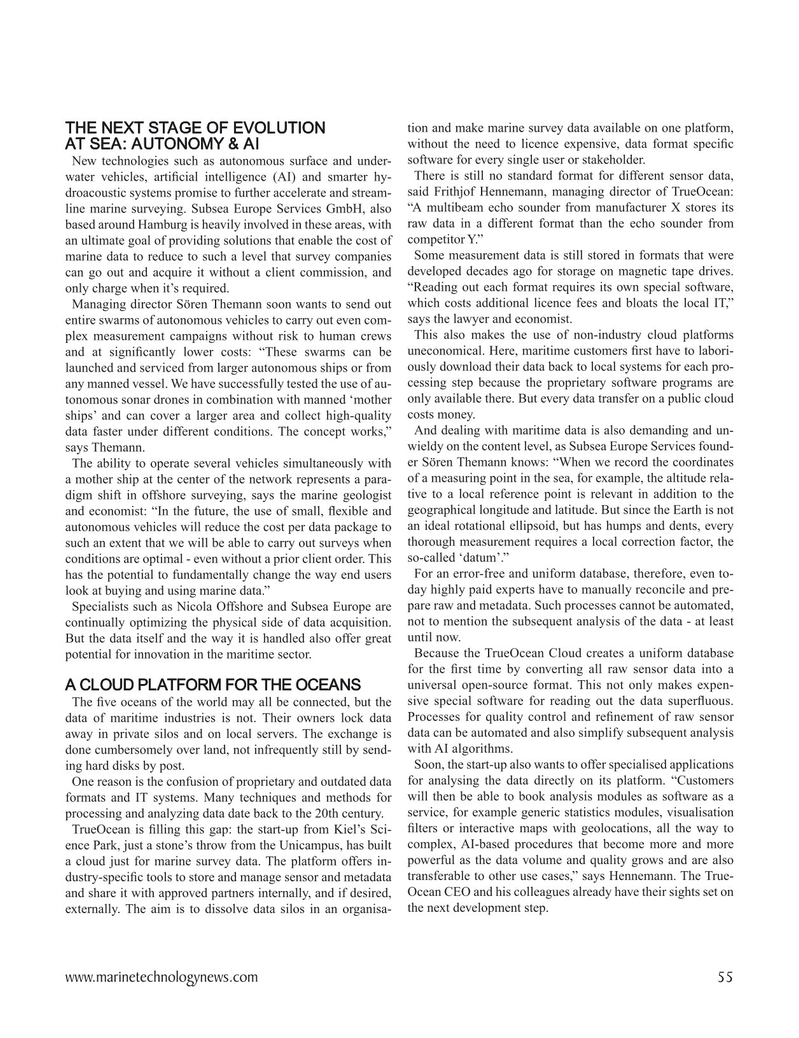
Page 55: of Marine Technology Magazine (November 2022)
Read this page in Pdf, Flash or Html5 edition of November 2022 Marine Technology Magazine
tion and make marine survey data available on one platform,
THE NEXT STAGE OF EVOLUTION without the need to licence expensive, data format speci? c
AT SEA: AUTONOMY & AI
New technologies such as autonomous surface and under- software for every single user or stakeholder. water vehicles, arti? cial intelligence (AI) and smarter hy- There is still no standard format for different sensor data, droacoustic systems promise to further accelerate and stream- said Frithjof Hennemann, managing director of TrueOcean: line marine surveying. Subsea Europe Services GmbH, also “A multibeam echo sounder from manufacturer X stores its based around Hamburg is heavily involved in these areas, with raw data in a different format than the echo sounder from an ultimate goal of providing solutions that enable the cost of competitor Y.” marine data to reduce to such a level that survey companies Some measurement data is still stored in formats that were can go out and acquire it without a client commission, and developed decades ago for storage on magnetic tape drives. only charge when it’s required. “Reading out each format requires its own special software,
Managing director Sören Themann soon wants to send out which costs additional licence fees and bloats the local IT,” entire swarms of autonomous vehicles to carry out even com- says the lawyer and economist.
plex measurement campaigns without risk to human crews This also makes the use of non-industry cloud platforms and at signi? cantly lower costs: “These swarms can be uneconomical. Here, maritime customers ? rst have to labori- launched and serviced from larger autonomous ships or from ously download their data back to local systems for each pro- any manned vessel. We have successfully tested the use of au- cessing step because the proprietary software programs are tonomous sonar drones in combination with manned ‘mother only available there. But every data transfer on a public cloud ships’ and can cover a larger area and collect high-quality costs money.
data faster under different conditions. The concept works,” And dealing with maritime data is also demanding and un- says Themann. wieldy on the content level, as Subsea Europe Services found-
The ability to operate several vehicles simultaneously with er Sören Themann knows: “When we record the coordinates a mother ship at the center of the network represents a para- of a measuring point in the sea, for example, the altitude rela- digm shift in offshore surveying, says the marine geologist tive to a local reference point is relevant in addition to the and economist: “In the future, the use of small, ? exible and geographical longitude and latitude. But since the Earth is not autonomous vehicles will reduce the cost per data package to an ideal rotational ellipsoid, but has humps and dents, every such an extent that we will be able to carry out surveys when thorough measurement requires a local correction factor, the conditions are optimal - even without a prior client order. This so-called ‘datum’.” has the potential to fundamentally change the way end users For an error-free and uniform database, therefore, even to- look at buying and using marine data.” day highly paid experts have to manually reconcile and pre-
Specialists such as Nicola Offshore and Subsea Europe are pare raw and metadata. Such processes cannot be automated, continually optimizing the physical side of data acquisition. not to mention the subsequent analysis of the data - at least
But the data itself and the way it is handled also offer great until now.
potential for innovation in the maritime sector. Because the TrueOcean Cloud creates a uniform database for the ? rst time by converting all raw sensor data into a universal open-source format. This not only makes expen-
A CLOUD PLATFORM FOR THE OCEANS
The ? ve oceans of the world may all be connected, but the sive special software for reading out the data super? uous. data of maritime industries is not. Their owners lock data Processes for quality control and re? nement of raw sensor away in private silos and on local servers. The exchange is data can be automated and also simplify subsequent analysis done cumbersomely over land, not infrequently still by send- with AI algorithms. ing hard disks by post. Soon, the start-up also wants to offer specialised applications
One reason is the confusion of proprietary and outdated data for analysing the data directly on its platform. “Customers formats and IT systems. Many techniques and methods for will then be able to book analysis modules as software as a processing and analyzing data date back to the 20th century. service, for example generic statistics modules, visualisation
TrueOcean is ? lling this gap: the start-up from Kiel’s Sci- ? lters or interactive maps with geolocations, all the way to ence Park, just a stone’s throw from the Unicampus, has built complex, AI-based procedures that become more and more a cloud just for marine survey data. The platform offers in- powerful as the data volume and quality grows and are also dustry-speci? c tools to store and manage sensor and metadata transferable to other use cases,” says Hennemann. The True- and share it with approved partners internally, and if desired, Ocean CEO and his colleagues already have their sights set on externally. The aim is to dissolve data silos in an organisa- the next development step.
www.marinetechnologynews.com 55
MTR #8 (50-63).indd 55 11/29/2022 4:09:53 PM

 54
54

 56
56
